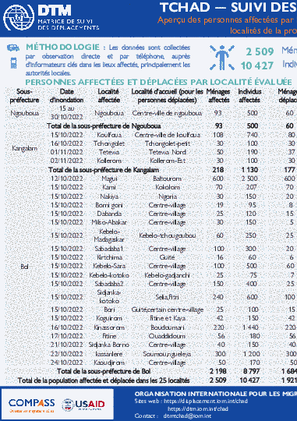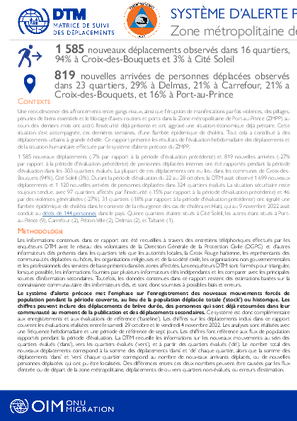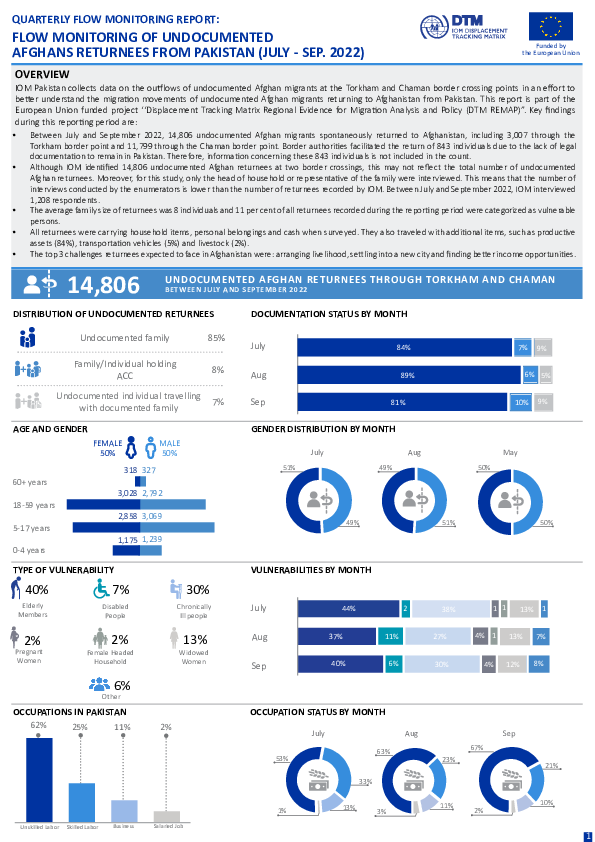-
Countries
-
Data and Analysis
-
Special Focus
-
Crisis Responses

Contact
DTM Tchad, dtmtchad@iom.int
Language
French
Location
Chad
Period Covered
Oct 21 2022
Nov 10 2022
Activity
- Mobility Tracking
- Event Tracking
Le suivi des urgences a pour but de recueillir des informations sur les mouvements importants et soudains de populations ainsi que sur des urgences sécuritaires et climatiques. Chaque année au Tchad, durant la saison pluvieuse (Mai-Septembre), plusieurs localités sont souvent atteintes par des inondations, touchant des milliers de personnes. Ce tableau de bord présente les informations sur les inondations fluviales survenues en octobre 2022 dans 3 sous-préfectures de la province du Lac, affectant ainsi 1 351 ménages (5 837 individus). Ces informations ont été collectées à travers des entretiens téléphoniques avec les informateurs clés notamment les autorités locales dans la province affectée.
Suite à la montée des eaux du Lac Tchad survenue durant la période du 15 au 30 octobre 2022, 17 localités situées dans les sous-préfectures de Bol, Ngouboua et Kangalam (département de Kaya et Mamdi, province du Lac) ont été inondés. Au total, 1 351 ménages (5 837 individus) ont été affectés par ces inondations. Parmi ces personnes, 776 ménages (3 756 individus) se sont déplacés dans les mêmes sous-préfectures et accueillis par les membres de la communauté locale. Il est à indiquer que cette catastrophe a causé des dommages critiques aux habitations, aux 1378 hectares des champs des riz, maïs, mil et entrainé la perte de bétail. Ainsi, une assistance humanitaire d’urgence est nécessaire. Vu que, ces personnes vivent dans une situation d’extrême vulnérabilité et ont soulignés des besoins importants en abris, vivres et articles non alimentaires.
Haiti – Système D’alerte Précoce pour les Déplacements – Nouvelles arrivées (22 – 28 Octobre 2022)
Haiti – Système D’alerte Précoce pour les Déplacements – Nouveaux déplacements (22 – 28 Octobre 2022)
Contact
DTM Somalia Location
Somalia
Activity
- Mobility Tracking
- Event Tracking
Period Covered
Sep 17 2022 -Nov 17 2022
In early 2022, as the drought continued to worsen with displacement increasing in Somalia, DTM team started to pilot an Emergency Trends Tracking (ETT) tool in Gedo region to monitor displacement trends and hotspots in support of operational planning. In July 2022, four failed consecutive rainy seasons have resulted in 90% of the country experiencing severe drought conditions. Considering the extension of the drought, DTM team decided to expand its ETT to Bay region as data providers reported significant displacements from June 2022 in the region. To avoid duplication/maximization of resources, this expansion was done in close coordination with the CCCM Cluster to ensure that the ETT focuses on host community locations and IDP sites that are not covered by the CCCM Cluster’s New Arrivals tracker. This is to avoid duplication and ensure maximization of resources.
ETT is a crisis-based tool that tracks sudden displacement triggered by specific events or emerging crises. The objective of ETT is to help prioritize humanitarian response and to enable partners to deliver rapid assistance. Based on previous drought induced displacement patterns, and the ones observed since the beginning of the drought, the humanitarian community expects that people will move from rural to urban areas in search of humanitarian services. Consequently, this ETT tool which concentrates only on drought induced displacements, focuses on the main urban centers and surrounding villages for each district. The data is collected through Key Informant Interviews (KIIs) at the location level, from Sunday to Wednesday every week. All locations assessed are monitored each week.
The CCCM Cluster New Arrivals was established in early 2022 in response to the drought to provide weekly updates on new arrivals entering CCCM partner managed IDPs sites. The system allows CCCM partners network staff to report daily or weekly on new arrivals in CCCM partner managed sites.
Population Groups
Survey Methodology
Unit of Analysis Or Observation
Type of Survey or Assessment
Keywords
Geographical Scope
Administrative boundaries with available data
The current dataset covers the following administrative boundaries

Contact
DTM Nigeria, AllUsersInDTMNigeria@iom.int
Language
English
Location
Nigeria
Period Covered
Oct 31 2022
Nov 06 2022
Activity
- Mobility Tracking
- Event Tracking
On 3rd of November, armed bandits reportedly attacked the communities Udar Yagba and Ukohol in Nyiev ward of Guma LGA in Benue State. The attacks affected 837 individuals, who were displaced to the communities Ortesy in Nyiev ward and Ndzorov in Ndzorov Council ward. As a result of the attacks, 15 fatalities and 36 injuries were reported.
On 5th of Novmber, armed bandits reportedly attacked the communities Udei and Yeluwata in Nyiev ward of Guma LGA in Benue State. The attacks affected 196 individuals, who were displaced to Ortesy IDP Camp in Nyiev ward. As a result of the attacks, 10 fatalities and 3 injuries were reported.

Contact
DTM Nigeria, AllUsersInDTMNigeria@iom.int
Language
English
Location
Nigeria
Period Covered
Oct 31 2022
Nov 06 2022
Activity
- Mobility Tracking
- Event Tracking
The DTM Emergency Tracking Tool (ETT) is deployed to track and to collect information on large and sudden population movements, provide frequent updates on the scale of displacement and quantify the affected population when needed. As a sub-component of the Mobility Tracking methodology in Nigeria, ETT utilises direct observation and a broad network of key informants to capture best estimates of the affected population per location, enabling targeted humanitarian response planning.
Between 31 October and 06 November 2022, a total of 1,486 new arrivals were recorded in locations in Adamawa, Borno and Yobe States. The new arrivals were recorded at locations in Askira/Uba, Bama, Dikwa, Gwoza, Kala Balge, Monguno, and Ngala Local Government Areas (LGAs) of the most conflict-affected state of Borno, in Fufore, Girei, Gombi, Hong, Lamurde, Michika, Mubi South, Mubi North, Yola North, Yola South and Song LGAs of Adamawa and in Damaturu LGA of Yobe State.

Contact
dtmhaiti@iom.int
Language
French
Location
Haiti
Period Covered
Oct 29 2022
Nov 04 2022
Activity
- Event Tracking
Une recrudescence des affrontements entre gangs rivaux, ainsi que l'éruption de manifestations parfois violentes, des pillages, pénuries de biens essentiels et le blocage d'axes routiers et ports dans la Zone métropolitaine de Port-au-Prince (ZMPP) au cours des derniers mois ont accrû l'insécurité déjà présente et ont aggravé une situation économique déjà précaire. Cette situation s'est accompagnée, ces dernières semaines, d'une flambée épidemique de choléra. Tout cela a contribué à des déplacements urbains à grande échelle.
Ce rapport présente les résultats de l'évaluation hebdomadaire des déplacements et de la situation humanitaire effectuée par le système d'alerte précoce du ZMPP. 1 585 nouveaux déplacements (-7% par rapport à la période d'évaluation précédente) et 819 nouvelles arrivées (-27% par rapport à la période d'évaluation précédente) de personnes déplacées internes ont été rapportés pendant la période d’évaluation dans les 303 quartiers évalués. La plupart de ces déplacements ont eu lieu dans les communes de Croix-des-Bouquets (94%), Cité Soleil (3%). Durant la période d’évaluation du 22 au 28 octobre, la DTM avait observé 1 699 nouveaux déplacements et 1 120 nouvelles arrivées de personnes déplacées dans 324 quartiers évalués.
La situation sécuritaire reste toujours tendue, avec 97 quartiers affectés par l'insécurité (-15% par rapport à la période d'évaluation précédente) et 46 par des violences généralisées (-27%). 31 quartiers (-18% par rapport à la période d'évaluation précédente) ont signalé une flambée épidémique de choléra dans le contexte de la résurgence des cas de choléra en Haïti, qui au 9 novembre 2022 avait conduit au décès de 144 personnes dans le pays. Quinze quartiers étaient situés à Cité Soleil, les autres étant situés à Port-au-Prince (9), Carrefour (2), Pétion-Ville (2), Delmas (2), et Tabarre (1).

Contact
DTM Uganda, dtmuganda@iom.int
Language
English
Location
Uganda
Period Covered
Sep 01 2022
Sep 30 2022
Activity
- Flow Monitoring
In September 2022, a total of 2,007 people were interviewed at four Flow Monitoring Points (FMPs) across the border between Uganda and Kenya. The majority of people interviewed were incoming to Uganda (57%) against outgoing to Kenya (43%).
More inflows were observed during the reporting period as compared to outflows across most flow monitoring points as illustrated in the map. Most people acquire information about jobs or business offers across the border from friends, relatives or community at their usual residences or at places of destination. The majority (56%) of outgoing movements are for economic reasons.

Contact
DTM Pakistan, iomisbdtmremapteam@iom.int
Language
English
Location
Pakistan
Period Covered
Oct 08 2022
Oct 21 2022
Activity
- Flow Monitoring
IOM Pakistan collects data on the outflows of undocumented Afghan migrants at the Torkham and Chaman border crossing points in an effort to better understand the migration movements of undocumented Afghan migrants returning to Afghanistan from Pakistan. This exercise is part of the European Union funded project “Displacement Tracking Matrix Regional Evidence for Migration Analysis and Policy (DTM REMAP)”.
Between 8 October and 21 October 2022, 3,054 undocumented Afghan migrants spontaneously returned to Afghanistan, including 391 through the Torkham border point and 2,663 through the Chaman border point. Border authorities facilitated the return of 99 individuals due to the lack of legal documentation to remain in Pakistan. Therefore, information concerning these individuals are not included in the count. Although IOM identified 3,054 undocumented Afghan returnees at two border crossings, this may not reflect the total number of undocumented Afghan returnees. Moreover, for this study, only the head of household or representative of the family were interviewed. This means that the number of interviews conducted by the enumerators is lower than the number of returnees recorded by IOM. Between 8 and 21 October 2022, IOM interviewed 197 respondents.

Contact
DTM Pakistan, iomisbdtmremapteam@iom.int
Language
English
Location
Pakistan
Period Covered
Jul 01 2022
Sep 30 2022
Activity
- Flow Monitoring
IOM Pakistan collects data on the outflows of undocumented Afghan migrants at the Torkham and Chaman border crossing points in an effort to better understand the migration movements of undocumented Afghan migrants returning to Afghanistan from Pakistan. This report is part of the European Union funded project ‘‘Displacement Tracking Matrix Regional Evidence for Migration Analysis and Policy (DTM REMAP)”. Key findings during this reporting period are:
- Between July and September 2022, 14,806 undocumented Afghan migrants spontaneously returned to Afghanistan, including 3,007 through the Torkham border point and 11,799 through the Chaman border point. Border authorities facilitated the return of 843 individuals due to the lack of legal documentation to remain in Pakistan. Therefore, information concerning these 843 individuals is not included in the count.
- Although IOM identified 14,806 undocumented Afghan returnees at two border crossings, this may not reflect the total number of undocumented Afghan returnees. Moreover, for this study, only the head of household or representative of the family were interviewed. This means that the number of interviews conducted by the enumerators is lower than the number of returnees recorded by IOM. Between July and September 2022, IOM interviewed 1,208 respondents.
- The average family size of returnees was 8 individuals and 11 per cent of all returnees recorded during the reporting period were categorized as vulnerable persons.
- All returnees were carrying household items, personal belongings and cash when surveyed. They also traveled with additional items, such as productive assets (84%), transportation vehicles (5%) and livestock (2%).
- The top 3 challenges returnees expected to face in Afghanistan were: arranging livelihood, settling into a new city and finding better income opportunities


